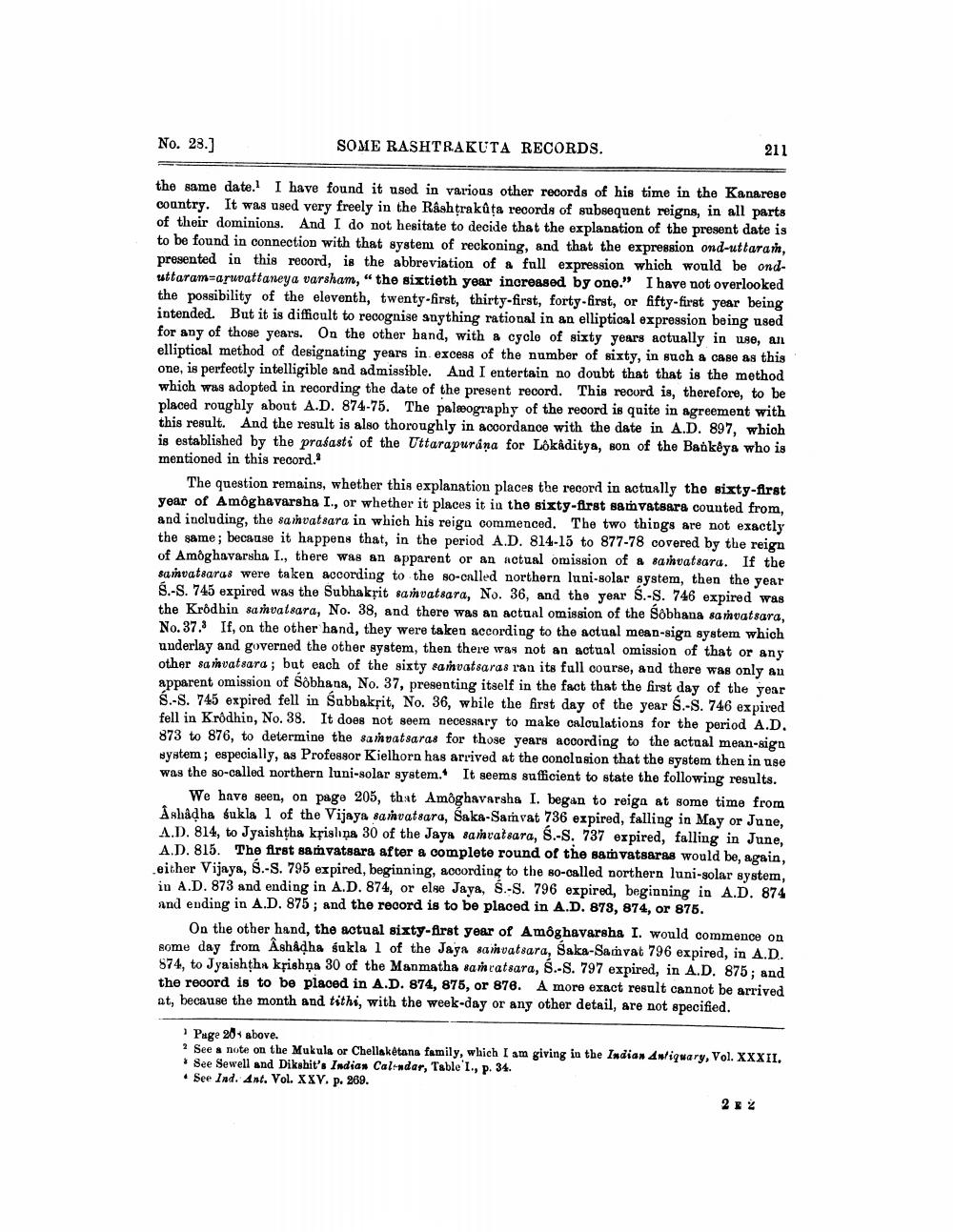________________
No. 23.)
SOME RASHTRAKUTA RECORDS.
211
the same date. I have found it used in various other records of his time in the Kanarese country. It was used very freely in the Rashtrakūta records of subsequent reigns, in all parts of their dominions. And I do not hesitate to decide that the explanation of the present date is to be found in connection with that system of reckoning, and that the expression ond-uttaram, presented in this record, is the abbreviation of a full expression which would be onduttaram=asuvattaneya varsham," the sixtieth year increased by one." I have not overlooked the possibility of the eleventh, twenty-first, thirty-first, forty-first, or fifty-first year being intended. But it is difficult to recognise anything rational in an elliptical expression being used for any of those years. On the other hand, with a cycle of sixty years actually in use, an elliptical method of designating years in excess of the number of sixty, in such a case as this one, is perfectly intelligible and admissible. And I entertain no doubt that that is the method which was adopted in recording the date of the present record. This record is, therefore, to be placed roughly abont A.D. 874-75. The palæography of the record is quite in agreement with this result. And the result is also thoroughly in accordance with the date in A.D. 897, which is established by the prasasti of the Uttarapurana for Løkåditya, son of the Bankėya who is mentioned in this record.
The question remains, whether this explanation places the record in actually the sixty-first year of Amôghavarsha I., or whether it places it in the sixty-first samvatsara counted from, and including, the samvatsara in which his reiga commenced. The two things are not exactly the same; because it happens that, in the period A.D. 814-15 to 877-78 covered by the reign of Amoghavarsha I., there was an apparent or an actual omission of a samvatsara. If the samvatsaras were taken according to the so-called northern luni-solar system, then the year S.-S. 745 expired was the Subhakřit samvatsara, No. 36, and the year S.-S. 746 expired was the Krödbin samvatsara, No. 38, and there was an actual omission of the Sobhana samvatsara, No. 37. If, on the other hand, they were taken according to the actual mean-sign system which underlay and governed the other system, then there was not an actual omission of that or any other samvatsara ; but each of the sixty samvatsaras ran its full course, and there was only an apparent omission of Sobhana, No. 37, presenting itself in the fact that the first day of the year S.-S. 745 expired fell in Subbaksit, No. 36, while the first day of the year s.-S. 746 expired fell in Krôdhin, No. 38. It does not seem necessary to make caloulations for the period A.D. 873 to 876, to determine the samvatsaras for those years according to the actual mean-sign system; especially, as Professor Kielhorn has arrived at the conclusion that the system then in use was the so-called northern luni-solar system. It seems sufficient to state the following results.
We have seen, on page 205, that Amôghavarsha I. began to reiga at some time from Åshâdha sukla 1 of the Vijaya samvatsara, Saka-Samvat 736 expired, falling in May or June, A.D. 814, to Jyaishtha krishna 30 of the Jaya samvatsara, S.-S. 737 expired, falling in June, A.D. 815. The first samvatsara after a complete round of the samvatsaras would be, again, either Vijaya, S.-S. 795 expired, beginning, according to the so-called northern luni-solar system, in A.D. 873 and ending in A.D. 874, or else Jaya, S.-S. 796 expired, beginning in A.D. 874 and ending in A.D. 875; and the record is to be placed in A.D. 873, 874, or 875.
On the other hand, the actual sixty-first year of Amôghavarsha I. would commence on some day from AshAdha sukla 1 of the Jaya samvatsara, Saka-Samvat 796 expired, in A.D. 874, to Jyaishtha krishna 30 of the Manmatha samratsara, S.-S. 797 expired, in A.D. 875; and the record is to be placed in A.D. 874, 875, or 876. A more exact result cannot be arrived at, because the month and tithi, with the week-day or any other detail, are not specified.
Page 20 above. ? See a note on the Mukula or Chellaketana family, which I am giving in the Indian Anliquary, Vol. XXXII. * See Sewell and Dikshit's Indian Calendar, Table I., p. 34. • See Ind. Ant. Vol. XXV. p. 269.
2 E 2




